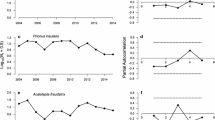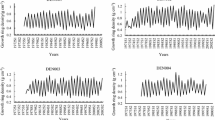Abstract
A time-series autoregressive moving average (ARMA) approach was used to develop stochastic models of tree crown profiles for five conifer species of the Sierran mixed conifer habitat type. Models consisted of three components: (1) a polynomial trend: (2) and ARMA model; and (3) rand om error. A Bayesian information criterion was used to evaluate alternative models. It was found that 70% of the crown profiles could be modeled using first-order ARMA [AR(1) or MA(1)] models, and that an additional 25% could be modeled using a white noise model [(AR(0)]. When the coefficients of the ARMA models were statistically significant, the models proved to be both visually and statistically an improvement over the polynomial trend (a Euclideam model). A binary classification system was used to determine if model type was related to tree or stand characteristics. Using this classification we found that it was possible to relat the appropriate model type to forest tree size and forest stand density with acceptable accuracy.
Similar content being viewed by others
References
Akaike, H. (1971), “Information Theory and an Extension of the Maximum Likelihood Principle,” Research Memorandum No. 46, Institute of Statistical Mathematics Tokyo, in 2nd International Symposium On Information Theory, eds. B.N. Petrov and F. Csaki, Budapest: Akademiai Kiade, pp. 267–281.
— (1974), “A New Look at the Statistical Model Identification,” IEEE Transactions on Automatic Control, AC-19, 716–722.
— (1978), “A Bayesian Analysis of the Minimum AIC Procedure,” Annals of the Institute of Statistical Mathematics, 30A, 9–14.
— (1979), “A Bayesian Extension of the Minimum AIC Procedure of Autoregressive Model Fitting,” Biometrika, 66, 237–242.
Assmann, E. (1970), The Principles of Forest Yield Study: Studies in the Organic Production, Structure, Increment, and Yield of Forest Stands, New York: Pergamon Press.
Baldwin, V. C. J., and Paterson, K. D. (1997), “Predicting the Crown Shape of Loblolly Pine Trees,” Canadian Journal of Forest Research, 27, 102–107.
Biging, G. S. and Dobbertin, M. (1992), “A Comparison of Distance-Dependent Competition Measures for Height and Basal Area Growth of Individual Conifer Trees,” Forest Science, 38, 695–720.
— (1995), “Evaluation of Competition Indices in Individual Tree Growth Models,” Forest Science, 41, 360–377.
Biging, G. S., and Gill, S. J. (1997), “Stochastic Models for Conifer Tree Crown Profiles,” Forest Science 43, 25–34.
Biging, G. S., and Wensel, L. C. (1990), “Estimation of Crown Form for Six Conifer Species of Northern California,” Canadian Journal of Forest Research, 20, 1137–1142.
Box, G. E. P., and Jenkins, G. M. (1970), Time-Series Analysis: Forecasting and Control, San Francisco: Holder-Day.
Breiman, L., Friedman, J. H., Olshen, R. A., and Stone, C. J. (1984), Classification and Regression Trees, Monterey, CA: Wadsworth and Brooks/Cole Advanced Books and Software.
Burkhart, H. E. (1992), “Scientific Visualization for the Study and Use of Forest Stand Simulators,” Landscape and Urban Planning, 21, 317–318.
Chatfield, C. (1989), The Analysis of Time Series: An Introduction, London, Chapman and Hall.
Cheney, W., and Kincaid, D. (1985), Numerical mathematics and Computing, Monterey, CA: Brooks/Cole Publishing
Colin, F., and Houllier, F. (1992), “Branchiness of Norway Spruce in Northeastern France: Predicting the Main Crown Characteristics from Usual Tree Measurements,” Annales des Sciences Forestieres (Paris), 49, 511–538.
Corona, P. (1991), “Studying Tree Crown Architecture by Fractal Analysis,” Italia Forestale E Montana, 46, 291–307.
Doruska, P. F., and Mays, J. E. (1998), “Crown Profile Modeling of Loblolly Pine by Nonparametric Regression Analysis,” Forest Science, 4, 445–453.
Dong, P. H., and Kramer, H. (1986), “Auswirkungen von Umweltbe lastungen auf das Wuchsverhalten verschiedener Nadelbaumarten in nordwestdeutschen Küstenraum, Der Forst-und Holzwirt, 41, 286–290.
ERDAS (1991), ERDAS Field Guide, Atlanta, GA: Author.
Ford, E. D., Avery, A., and Ford, R. (1990), “Simulation of Branch Growth in the Pinaceae: Interactions of Morphology, Phenology, Foliage Productivity, and the Requirement for Structural Support, on the Export of Carbon,” Journal of Theoretical Biology, 146, 15–36.
Ford, R. and Ford, E. D. (1990), “Structure and Basic Equations of a Simulator for Branch Growth in the Pinaceae,” Journal of Theoretical Biology, 146, 1–13.
Fuller, W. A. (1996), Introduction to Statistical Time Series (2nd ed.), New York: Wiley.
Gavrikov, V. L., and Karlin, I. V. (1992), “A Dynamic Model of Tree Terminal Growth,” Canadian Journal of Forest Research, 23, 326–329.
Gill, S. J. (1997), “Stochastic Models of Tree Crown Profiles,” unpublished Ph.D. Dissertation, University of California, Berkeley.
Gill, S. J., and Biging, G. S. (2002), “Autoregressive Moving Average (ARMA) Models of Crown Profiles for two California Hardwood Species,” Ecological Modelling, 152, 213–226.
Hann, D. W. (1999), “An Adjustable Predictor of Crown Profile for Stand-Grown Douglas-fir Trees,” Forest Science, 45, 217–225.
Jordan, D. N., and Lockaby, B. G. (1990), “Time Series Modeling of Relationships Between Climate and Long-Term Radial Growth of Loblolly Pine,” Canadian Journal of Forest Research, 20, 738–742.
Kershaw, J. A., and Maguire, D. A. (1996), “Crown Structure in Western Hemlock, Douglas-fir, and Grand Fir in Western Washington: Horizontal Distribution of Foliage Within Branches,” Canadian Journal of Forest Research, 26, 128–142.
Kramer, H. (1988), Waldwachstumsleire: Ökologische und anthropogene Einflüsse auf das Wachstum des Waldes, seine Massen-und Wertleistung und die Bestandessicherheit, Hamburg: Parey, Hans-Achim Gussone.
Kuuluvainen, T., and Pukkula, T. (1989), “Simulation of Within-tree and Between-tree Shading of Direct Radiation in a Forest Canopy: Effects of Crown Shape and Sun Elevation,” Ecological Modeling, 49, 89–100.
Maguire, D. A., Moeur, M., and Bennett, W. S. (1994), “Models for Describing Basal Diameter and Vertical Distribution of Primary Branches in Young Douglas-fir,” Forest Ecology and Management, 63, 23–55.
Mawson, J. C., Thomas, J. W., and DeGraff, R. M. (1976), “Program HTVOL The Determination of Tree Crown Volume by Layers,” USDA Forest Service Research Paper NE-3549.
McGaughey, R. J. (1998), “Techniques for Visualizing the Appearance of Forestry Operations,” Journal of Forestry, 96, 9–14.
Mitchell, K. J. (1975), “Dynamics and Simulated Yield of Douglas-fir,” Forest Science Monograph. 17.
Moeur, M. (1981), “Crown Width and Foliage Weight of Northern Rocky Mountain Conifers,” USDA Forest Service Research Paper INT-283.
Mohren, G. M. J., Gerwen, C. P. V., and Spitters, C. J. T. (1984), “Simulation of Primary Production in Even-aged Stands of Douglas-fir,” Forest Ecology and Management, 9, 27–49.
Monserud, R. A. (1986), “Time-Series Analysis of Tree-ring Chronologies,” Forest Science, 32, 349–272.
Morrison, M. L., Timossi, I. C., and With, K. A. (1987), “Development and Testing of Linear Regression Models Predicting Bird-habitat Relationships,” Jounral of Wildlife Management, 51, 247–253.
Nagel, J. (2001), “BWINPRO: Program for Stand Analysis and Prognosis User’s Manual for Version 6.02,” Abteilung Waldwahstum. Niedersächsische Forstliche Versuchsanstalt, 87.
Nepal, S. K., Somers, G. L., and Caudill, S. H. (1996), “A Stochastic Frontier Model for Fitting Tree Crown Shape in Loblolly Pine (Pinus taeda L.),” Journal of Agricultural, Biological, and Enviroumental Statistics, 1, 336–353.
Nelson, C. R. (1973), Applied Time Series Analysis for Managerial Forecasting, San Francisco, Holden-Day Inc.
Pretzsch, H. (1992), “Modellierung der Kronenkondurrenz von Fichte und Buche in Rein- und Mischbeständen,” in Allgemeine Forst-und Jagdzeitung 163, 11–12, 203–213.
Pretzsch, H. (1993), Analyse und Reproduktion räumlicher Bestandesstrukturen. Versuche mit dem Strukturgene rator STRUGEN, Schriften aus der Forstlichen Fakultät der Universität Göttingen und der Niedersächsischen Forstlichen Versuchsanstalt, Band 114, Sauerländer’s Verlag.
StataCorp. (1999), Stata Statistical Software: Release 6.0, College Station, TX: Stata Corporation.
SAS Institute Inc. (1999), SAS/STAT User’s Guide, Release 8.0. Cary, NC: SAS Institute Inc.
S-Plus (2000), Guide to Statistics, volumes 1–2, Seattle, WA: Data Analysis Products Division, MathSoft.
SPSS Inc. (1995), SPSS Release 6.1.1., Chicago, IL.
Zeide, B. (1998), “Fractal Analysis of Foliage Distribution in Loblolly Pine Crowns,” Canadian Journal of Forest Research, 28, 106–114.
Zeide, B., and Gresham, C. A. (1991), “Fractal Dimensions of Tree Crowns in Three Loblolly Pine Plantations of Coastal South Carolina,” Canadian Journal of Forest Research, 21, 1208–1212.
Zeide, B., and Pfeifer, P. (1991), “A Method for Estimation of Fractal Dimension of Tree Crowns,” Forest Science, 37, 1253–1265.
Author information
Authors and Affiliations
Corresponding author
Rights and permissions
About this article
Cite this article
Gill, S.J., Biging, G.S. Autoregressive moving average models of conifer crown profiles. JABES 7, 558–573 (2002). https://doi.org/10.1198/108571102762
Received:
Revised:
Issue Date:
DOI: https://doi.org/10.1198/108571102762




